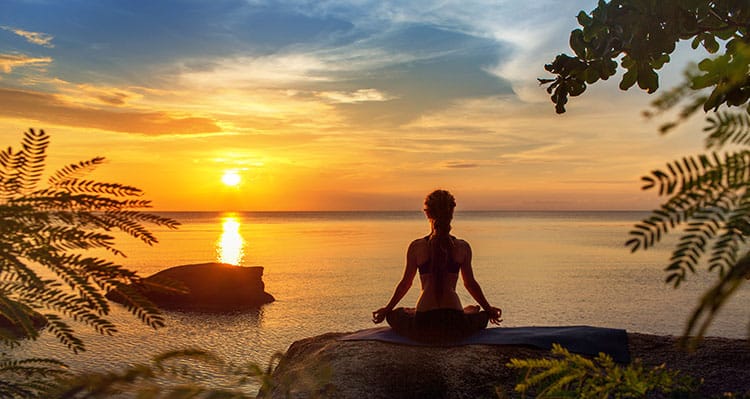Exploring Deep Relaxation Techniques in Meditation: A Comprehensive Guide

Are you looking to enhance your meditation practice and experience deep relaxation? Look no further!
This comprehensive guide will take you on a journey through various relaxation techniques in meditation. Discover the science behind relaxation, understand the benefits it brings, and explore different methods like progressive muscle relaxation and guided imagery.
Learn how to incorporate breathing exercises and find helpful tips for achieving and maintaining deep relaxation in your meditation sessions.
Key Takeaways
- Deep relaxation techniques in meditation promote calmness and relaxation in the brain by activating neurotransmitters like serotonin and GABA.
- Regular meditation practice trains the body to activate the relaxation response more efficiently, counteracting the harmful effects of chronic stress and improving sleep quality.
- Visualization and guided imagery are effective methods for achieving deep relaxation in meditation, promoting peace and reducing stress.
- Deep breathing techniques, such as diaphragmatic breathing and mindful breathing, help in relaxation, stress reduction, and improved focus, promoting a state of calmness and improved sleep quality.
The Science of Relaxation in Meditation
Now, let’s dive into the science behind how relaxation works in meditation.
When you engage in deep relaxation techniques during meditation, your body experiences a profound shift in its physiological state. One key aspect of this process is the role of neurotransmitters in relaxation.
Neurotransmitters such as serotonin and gamma-aminobutyric acid (GABA) play a crucial role in promoting a sense of calm and relaxation in the brain. These neurotransmitters help to regulate mood and reduce anxiety, allowing you to experience a deeper state of relaxation during meditation.
Furthermore, the impact of stress on the relaxation response is an important factor to consider. When you are stressed, your body releases stress hormones like cortisol, which can interfere with the relaxation process.
However, through regular meditation practice, you can train your body to activate the relaxation response more efficiently, counteracting the negative effects of stress. By focusing your attention and engaging in deep breathing exercises, you can signal your body to release relaxation-promoting neurotransmitters and reduce the impact of stress on your overall well-being.
Meditation truly offers a scientific pathway to achieving deep relaxation and inner peace.
Understanding the Benefits of Deep Relaxation in Meditation
Discover how understanding the advantages of achieving a state of deep relaxation can greatly enhance your meditation practice.
When you delve into the world of deep relaxation in meditation, you unlock a whole new level of benefits. By understanding the physiological effects of deep relaxation in meditation, you can optimize your practice and experience profound transformations.
Deep relaxation activates the parasympathetic nervous system, triggering a cascade of physiological responses that promote healing and rejuvenation. This state of relaxation counteracts the harmful effects of chronic stress, reducing anxiety, improving sleep quality, and boosting immune function.
As you deepen your relaxation in meditation, you cultivate a powerful connection between your mind and body, allowing you to release tension and find inner peace.
Embrace the transformative power of deep relaxation in your meditation practice and experience the profound benefits it brings.
Exploring Different Types of Relaxation Techniques in Meditation
By delving into various relaxation methods in meditation, you can enhance your practice and experience a multitude of benefits.
One of the most effective ways to achieve deep relaxation is by exploring different relaxation methods. These methods can help you release tension, reduce stress, and promote overall well-being.
One technique you can try is visualization. This involves creating a mental image or scenario that brings about feelings of calmness and peace. Close your eyes and imagine yourself in a serene setting, such as a beautiful beach or a peaceful forest. As you visualize, focus on the details and let yourself fully immerse in the experience.
Visualization can transport you to a state of deep relaxation, allowing your mind and body to unwind and rejuvenate. Give it a try and discover the transformative power of visualization in your meditation practice.
Step-by-Step Guide to Practicing Progressive Muscle Relaxation in Meditation
To practice progressive muscle relaxation in meditation, start by finding a comfortable position and gradually tense and relax each muscle group in your body.
This technique involves systematically tensing and releasing various muscle groups to promote deep relaxation.
Begin by focusing on your feet and toes, tensing them for a few seconds and then releasing the tension, allowing them to relax completely.
Move up to your calves, thighs, and so on, working your way up through your entire body.
This body scan technique helps to release any built-up tension and promotes a sense of physical and mental relaxation.
As you progress through each muscle group, notice any sensations or feelings that arise, and let go of any tension or stress you may be holding onto.
Using Guided Imagery for Deep Relaxation in Meditation
When it comes to deep relaxation in meditation, one effective technique is using guided imagery. By visualizing peaceful natural scenes, such as a serene beach or a tranquil forest, you can create a sense of calm and tranquility within yourself.
The benefits of guided imagery include reducing stress and anxiety, improving focus and concentration, and promoting overall well-being. By enhancing relaxation through imagery, you can tap into the power of your imagination to create a peaceful and rejuvenating meditation experience.
Visualizing Peaceful Natural Scenes
Imagining yourself in a serene natural setting can help induce a state of deep relaxation. Creating peaceful mental images and connecting with nature during meditation can transport you to a tranquil oasis within your mind.
Picture yourself sitting on a soft, moss-covered rock by a gently flowing stream. The sound of water cascading over smooth stones soothes your senses, while the warm rays of the sun caress your skin. Birds chirping in the distance create a symphony of peaceful sounds.
As you close your eyes, you envision tall trees swaying in the breeze, their leaves whispering secrets to the wind. You can almost smell the fresh scent of flowers blooming nearby.
Allowing yourself to be fully present in this imaginary scene, you feel a sense of calm wash over you, releasing tension and inviting deep relaxation.
Benefits of Guided Imagery
By engaging in guided imagery, you can tap into the power of your imagination to enhance your well-being and reduce stress. Guided imagery is a powerful relaxation technique that allows you to create vivid mental images that promote deep relaxation and calmness. Here are five benefits of incorporating guided imagery into your daily routine:
- Improved focus: Guided imagery helps train your mind to stay focused on the present moment, improving your ability to concentrate and stay engaged.
- Reduced stress: By immersing yourself in soothing mental images, guided imagery can help lower your stress levels and promote a sense of calm.
- Enhanced creativity: Engaging in guided imagery stimulates your imagination, allowing you to think outside the box and come up with innovative ideas.
- Boosted mood: The positive and uplifting images you create during guided imagery can help improve your mood and overall sense of well-being.
- Increased self-awareness: Guided imagery encourages introspection and self-reflection, helping you gain a deeper understanding of yourself and your emotions.
Incorporating guided imagery into your daily routine can have profound effects on your mental and emotional well-being. So why not give it a try and experience the benefits for yourself?
Enhancing Relaxation Through Imagery
Now that you understand the benefits of guided imagery, let’s explore how you can enhance relaxation through imagery. One powerful technique is creative visualization. This involves using your imagination to create vivid mental images that promote relaxation and well-being. For example, you can imagine yourself in a peaceful, serene setting like a beach or a forest, focusing on the sights, sounds, and sensations.
Another effective method is using affirmations for relaxation. Affirmations are positive statements that you repeat to yourself to reinforce a particular belief or state of mind. By using affirmations related to relaxation, such as “I am calm and at peace,” you can train your mind to enter a deeply relaxed state.
To help you better understand and apply these techniques, here is a table summarizing the creative visualization and affirmations for relaxation:
| Creative Visualization Techniques | Using Affirmations for Relaxation |
|---|---|
| Imagine serene settings | Repeat positive statements |
| Focus on sights, sounds, sensations | Reinforce belief in relaxation |
| Use imagination to promote relaxation | Train your mind to relax |
Incorporating Breathing Exercises for Relaxation in Meditation
When it comes to incorporating breathing exercises for relaxation in meditation, there are several key points to consider.
First, breath awareness benefits your overall well-being by reducing stress and promoting a sense of calm.
Second, learning techniques for deep breathing can help you take full, nourishing breaths that oxygenate your body and relax your mind.
Finally, practicing mindful breathing allows you to focus on the present moment, bringing a sense of relaxation and inner peace.
Breath Awareness Benefits
Take a moment to consider the benefits of breath awareness in deep relaxation techniques. By incorporating breath awareness techniques, you can enhance your meditation practice and achieve a greater sense of calm and tranquility.
Here are some key advantages of practicing breath awareness:
- Improves focus and concentration: By directing your attention to your breath, you can train your mind to stay present in the moment.
- Reduces stress and anxiety: Deep breathing activates the relaxation response in your body, reducing the production of stress hormones and promoting a sense of calm.
- Enhances self-awareness: Paying attention to your breath allows you to become more in tune with your body and its sensations.
- Increases energy and vitality: Utilizing breath control methods can help improve the efficiency of your breathing, leading to increased energy levels.
- Promotes emotional well-being: Breath awareness can help regulate your emotions and create a sense of inner peace.
Incorporating breath awareness into your deep relaxation techniques can have profound effects on your overall well-being. Take a deep breath and experience the benefits for yourself.
Techniques for Deep Breathing
To enhance your breath awareness practice, try incorporating different techniques for deep breathing. Deep breathing techniques can help you relax, reduce stress, and improve focus. One effective technique is alternate nostril breathing. This technique involves using your fingers to alternately close and open your nostrils while you breathe deeply. It helps balance the flow of energy in your body and promotes a sense of calm. Another technique is diaphragmatic breathing, where you focus on breathing deeply into your belly rather than shallowly into your chest. This technique can help you access a state of deep relaxation. Experiment with these techniques and find what works best for you. Remember, deep breathing is a powerful tool for relaxation and self-care.
| Technique | Description | Benefits |
|---|---|---|
| Alternate Nostril | Close one nostril with finger, exhale, then | Balances energy flow, promotes calm |
| Breathing | inhale through the open nostril. Switch nostrils | |
| Diaphragmatic | Breathe deeply into your belly, feel it expand | Access deep relaxation, reduce stress |
| Breathing | as you inhale, contract as you exhale | |
Relaxation Through Mindful Breathing
If you want to relax and cultivate mindfulness, try incorporating mindful breathing into your daily routine.
Mindful breathing techniques and breath control methods can help you achieve a deep state of relaxation and promote overall well-being.
Here are some benefits of practicing mindful breathing:
- Reduced stress and anxiety
- Improved focus and concentration
- Enhanced self-awareness
- Increased relaxation and calmness
- Improved sleep quality
To practice mindful breathing, find a quiet and comfortable spot. Close your eyes and take a deep breath in through your nose, allowing your belly to expand. Then, exhale slowly through your mouth, releasing any tension or stress.
Repeat this process, focusing on your breath and letting go of any distracting thoughts.
Tips for Achieving and Maintaining Deep Relaxation in Meditation
Start by focusing on your breath and allowing yourself to fully relax into the present moment. This is the first step towards achieving mindfulness and finding inner peace in your meditation practice. Deep relaxation is essential for a more profound and fulfilling meditation experience. Here are some tips to help you achieve and maintain deep relaxation:
| Tips for Achieving and Maintaining Deep Relaxation |
|---|
| 1. Create a peaceful environment. |
| 2. Find a comfortable posture. |
| 3. Let go of any tension or stress in your body. |
| 4. Focus on your breath and let your thoughts drift away. |
Frequently Asked Questions
Can Deep Relaxation Techniques in Meditation Help With Anxiety and Stress Reduction?
Yes, deep relaxation techniques in meditation can help with anxiety and stress reduction. By practicing deep relaxation techniques for panic attacks and stress relief, you can experience a sense of calm and peace.
How Long Does It Take to Experience the Benefits of Deep Relaxation in Meditation?
You may start experiencing the benefits of deep relaxation in meditation in just a few weeks. Exploring the timeline of these benefits can help you understand how long it takes to feel the effects.
Are There Any Specific Deep Relaxation Techniques That Are More Effective for Beginners?
There are a few effective deep relaxation techniques for beginners. Some popular ones include progressive muscle relaxation, guided imagery, and deep breathing exercises. These techniques can help you achieve a state of deep relaxation.
Can Deep Relaxation in Meditation Improve Sleep Quality?
Deep relaxation in meditation can improve your sleep quality. It promotes relaxation, reduces stress, and enhances cognitive function. It can also provide relief from chronic pain, allowing for a more restful and rejuvenating sleep.
Are There Any Potential Side Effects or Risks Associated With Practicing Deep Relaxation Techniques in Meditation?
There may be potential risks and safety concerns associated with practicing deep relaxation techniques in meditation. It is important to be aware of any potential side effects and consult with a healthcare professional if needed.









